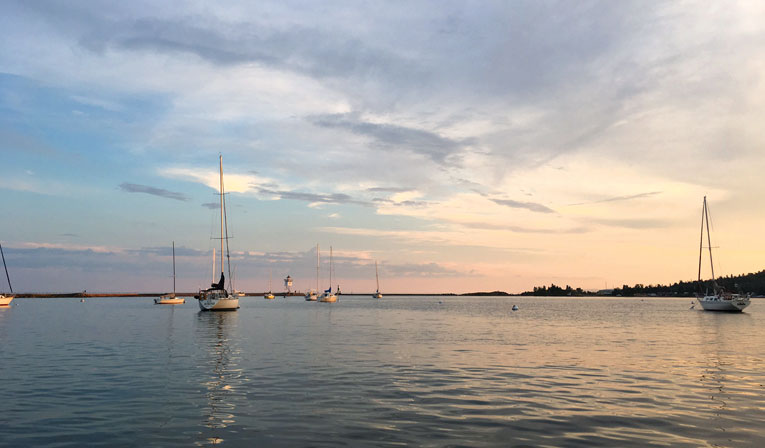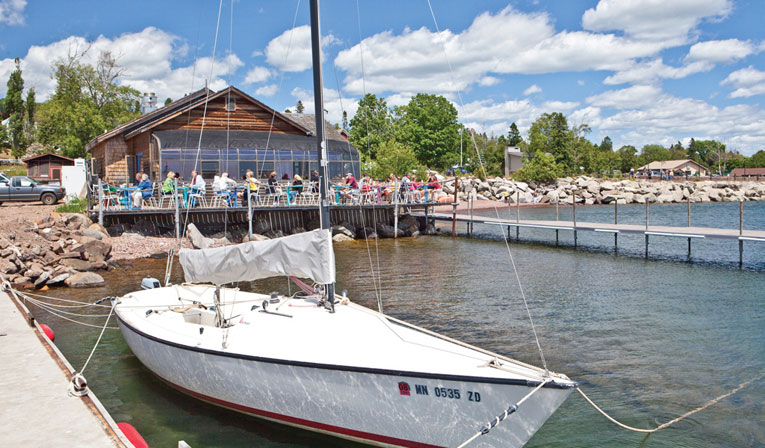Photo by Kat B.
On the lonely, rocky northern shore of Lake Superior, captains and crews seek the welcome refuge of Grand Marais, Minnesota — a vibrant arts community and sweet waypoint nestled in the rugged wilderness of water and forest.
With the Sawtooth Mountains as a dramatic backdrop and a population of 1,351 in the off-season months (and probably double that in the summer), Grand Marais was voted USA Today’s 2017 Best Midwestern Small Town, Budget Travel’s 2015 Coolest Small Town in America, and Lake Superior Magazine’s 2015 Best Weekend Destination.
The Ojibwe name for the area, Gichi-biitoobiig (meaning “double body of water”), is inspired by the broad tombolo at the shoreline that creates two natural harbors and has long-served as a historical meeting point. The original European voyageurs, fur traders and big lake fishermen converged here. Today, Grand Marais is an access point into the Boundary Waters Canoe Area, a jumping off point for Isle Royale National Park, and home to the North House Folk School, one of the oldest, established folk schools in the country.
I first encountered Grand Marais after spending a week on Isle Royale aboard our 38-foot trawler, Mazurka. My husband, Mark, and I took our three kids — then 5, 2, and 11 months old — to the big island for real wilderness immersion. After seven days of hiking, berry picking, fishing and little contact with the outside world, we were ready to return to society. Grand Marais was the sweetest re-entry point imaginable. Its welcoming charm greeted us from the water, and it proved just the right size to ease us back into daily life. Wi-Fi! Cell phones! Restaurants, shops, provisions — all within walking distance of the marina. It was the friendliest community a boater could hope to find anywhere.
“I see us as an oasis,” says Dave Tersteeg, director of Parks and Recreation, who oversees the municipal Grand Marais Marina and its adjacent campground. “We’re on the desolate north shore of no services. Everyone says they’re so happy and so relieved to get here because they’ve been waiting 10 hours. You have delayed gratification getting here.”
Tie up
The Grand Marais Marina offers gas and diesel fuel, pumpout, electricity and water at its 19 seasonal and two transient slips. The marina can accommodate boats up to 50 feet at the docks and even larger at the mooring buoys. What the marina lacks in space, it makes up for in hospitality. Last year, one of our transient neighbors told us, “Every year we call to get a slip and they’re all taken, but somehow Dave gets us in.”
The “we’ll find a spot for you” customer service is an important aspect of the Grand Marais Marina.
“I’m a boater and I know what it’s like to get that kind of service,” says Tersteeg. “These boats have needs and I try to meet them. I’m in tune with the fleet of seasonals — it’s pretty often that someone is out to the island or someone is broken down.”
Even if Dave’s magic can’t find you a slip, there are other options: Nine buoy moorings are open in the east harbor and can accommodate boats more than 50 feet. Boats can also anchor in the west side where there’s good holding ground. At the east side, there are wall tie-ups near the Coast Guard Station and along the harbor wall for a small fee.
Luckily for boaters, no matter where you moor your boat, it’s close to everything.

Photo by Samantha Oller
Fisherman’s Picnic
 Held the first week of August, the annual Fisherman’s Picnic brings 10,000 to 15,000 visitors to the Grand Marais lakefront for a four-day festival.
Held the first week of August, the annual Fisherman’s Picnic brings 10,000 to 15,000 visitors to the Grand Marais lakefront for a four-day festival.
The hometown picnic started in the 1930s when Grand Marais was a small logging and fishing village and some neighbors decided to come together for a shore lunch. Today, attendees stroll through pop-up tents, shop at crazy daze sales and compete for prizes in the Big Fish contest, minnow races, loon calling, trail running and the professional log rolling tournament.
The Lions Club serves hundreds of its renowned fishburgers: Hand-breaded, deep-fried Lake Superior herring. There are fireworks on Saturday night, a parade on Sunday afternoon and two shows everyday with live bands.
Photo Courtesy of Lions Club
Photo by USCG Pete Markham
Tour d’Art
One step off the dock you’ll see why Grand Marais is known for its artists. The marina neighbors the North House Folk School, one of the oldest and most well-established folk schools in the nation. As you walk through the collection of outdoor and indoor work spaces, you can smell bread baking while watching artisans and their students hammer iron, build boats and carve furniture.
North House Folk School brings instructors from around the world to teach traditional northern crafts year-round; some classes last an afternoon, some last for weeks. It’s best to reserve a spot in advance; classes fill up fast.
The school’s mission is inspired by the Scandinavian “folkehøjskole,” or traditional folk school, where learning is valued for its own sake with a focus on traditional methods. Events and festivals are held at the school throughout the year including the annual Wooden Boat Show and Summer Solstice Festival. At this event, visitors can see handmade boats, eat traditional meals, try square dancing and watch craftsmen at work.
“It’s a great family event where you can taste the character of the school,” says Greg Wright, the school’s executive director.
While you’re in town, you can also take a class or listen to an artist’s talk at the Grand Marais Art Colony, which has been supporting artists since 1947. It offers classes, talks, activities, residencies and studio space. It began as a summer wilderness refuge for artists and now hosts events like the Grand Marais Arts Festival, Plein Air Grand Marais (an outdoor painting competition) and Tour d’Art, an annual home tour fundraiser.
If art is your passion, you’ll find galleries (and a whole lot more) in the downtown waterfront area, just a two-block walk from the marina.
The renowned Sivertson Gallery opened in 1980 by artist and author Howard Sivertson and his daughter, Jan Sivertson. Jan manages the gallery while Howard paints in watercolor and oil, creating scenes of the North Shore, Isle Royale and the Boundary Waters. The gallery exhibits artwork that reflects the character of Lake Superior. Today, Sivertson Gallery exhibits more than 60 regional artists, Canadian Inuit and Alaskan native art, and Canadian First Nation and Native American art.
Less than a block away, the Cook County Historical Society operates Johnson Heritage Post Art Gallery, which features local, regional and national artists in revolving exhibits. The gallery also displays a permanent collection of original art by the early 20th century pioneer and artist Anna Johnson, who influenced this area as an artist and art teacher, creating paintings, etchings, ceramics and stained glass.
If you’re looking for supplies, the eclectic Joy & Company sells a large variety of professional art supplies alongside local art, antiques, photography and jewelry. Stop by the backyard for barbecue, s’mores and the kids’ scratch pad, where you can pick for agates and other gemstones.
Shop local
The downtown area abounds with shops and bookstores. Lake Superior Trading Post is the area’s largest outdoor gear and gift store. Here you will find an eclectic array of men and women’s clothing, gear and camping supplies, maps, books, locally-made products and more. This family-owned retailer offers the expertise to get you geared up and on your way year-round. Joynes Ben Franklin is everybody’s favorite little department store, and Stone Harbor Wilderness Supply offers outdoor clothing, guided tours and outdoor rental gear.
Step inside Drury Lane Books to peruse its collection or listen to an author’s reading while gazing out at the big lake. Birchbark Books and Gifts sells new and used books, gifts and toys, and has a terrific play pit for kids to explore. And it would be tough to walk into Gunflint Mercantile without bringing home some fudge.
While you’re downtown, make sure to get a picture of the iconic Beaver House bait shop. You can’t miss it — there’s a huge walleye sticking out of the roof. Swing over to the Lightkeeper’s House Museum, which was built in 1896 and is listed on the National Register of Historic Places. Walking through the doors of this museum is like stepping back in time.

Photo Courtesy of visitcookcounty.com
Alfresco dining
If you’re ready for something besides onboard provisions, you’re in luck: Grand Marais hosts a unique collection of places to eat, without a chain restaurant in sight.
It’s important to note that while everything is open during the summer months, if you come during the off-season (it’s still beautiful, and the cross-country skiing is the best), double-check to see if the restaurant or shop you’ve been dying to try is open. Many venues operate seasonally.
The Crooked Spoon Café — led by Chef Nathan Hingos and his wife, Sara — uses local and regional ingredients whenever possible, and its menu changes seasonally. The cafe has a great selection of craft beer and wine. The Gun Flint Tavern offers soups, sandwiches, wraps and a full dinner menu. They also have an on-site micro-brewery and pub, and a rooftop deck where you can listen to live music on summer weekends. Sip craft beer at the Voyageur Brewing Company while looking out over its taproom and the big lake. The popular Angry Trout Café is inside an old commercial fishing shanty on the waterfront with a locally-based menu, including hand-harvested wild rice and their specialty: Fresh Lake Superior fish.
Looking for something quick? You can find provisions and more at the locally-owned Whole Foods Co-op, filled with organic produce, groceries, and ready-made sandwiches and soups.
Java Moose is open year-round with superb coffee, pastries, soup, sandwiches and a lot of ice cream. It’s the perfect pitstop before you head to the boardwalk or pick for rocks on the cobblestone beach overlooking Grand Marais Harbor.
No visit to Grand Marais would be complete without a stop at World’s Best Donuts. How many donuts do they make? This five-generation donut family proclaims, “Our grandma always said, ‘We make more donuts than McDonald’s sells hamburgers because they have time to count’.”
Get outdoors
After a good meal, explore some of Grand Marais’ excellent hiking and biking opportunities.
From downtown you can walk out past the Grand Marais Coast Guard Station to find the trailhead at the tombolo. From there, you can turn right to explore the Grand Marais Lighthouse nature trail, or left to hike out to Artist’s Point. Both trails offer stunning views of the lake, the town and the Sawtooth Mountains.
Heading northeast out of town, you’ll find the Pincushion Mountain Trail System — a local favorite with miles of excellent trails for hiking, running, biking and skiing. The parking area offers stunning views of the lake and is a popular picnic spot.
If you’re craving more adventure, you can drive up the historic Gunflint Trail National Scenic Byway, a two-lane paved road winding nearly 60 miles through boreal forest and glacier-created lakes to the Boundary Waters Canoe Area Wilderness. The trail is worth the trip; it has a unique history among fur traders, early pioneers and the Civilian Conservation Corps (CCC) camps. Your chances of spotting a moose are pretty high, and you can trek across the Laurentian Divide, hiking over some of the most ancient, exposed rock on the planet.
On your way back to the marina, you may want to wander through the Grand Marais Campground and RV Park, which has 300 campsites, including 57 primitive campsites with lake views or private wooded sites.
If you want to stay awhile in Grand Marais, check out the jazz-era Naniboujou Lodge and Restaurant built in 1928 on the shores of Lake Superior. The Lodge was originally intended to be a private sportsman’s club with members such as Babe Ruth and Jack Dempsey. It’s now on the National Registry of Historic Places and boasts a wondrously painted dining room ceiling and the largest stone fireplace in the state.
At the water’s edge on the west side of the harbor, you’ll find the historic Fish House replica and the fishing tug Neegee (which means “friend” in Ojibwe). The fish house, circa 1930, includes commercial fishing artifacts and a typical fish house scene with mannequins of a fisherman and his wife cleaning herring and preparing it for shipping to Duluth and Chicago. This display was created with help from area high school students.
Keep an eye out for the folk school’s 50-foot schooner, Hjørdis, which offers sailing courses to the Apostle Islands and Isle Royale.
While you’re at the beach, you may choose to do one of the best things in Grand Marais: Relax and watch the rolling waves on Lake Superior.
Whether you’re learning a new skill at the folk school, shopping, eating, hiking or napping — no matter what you do here — there’s never a bad day in Grand Marais.





